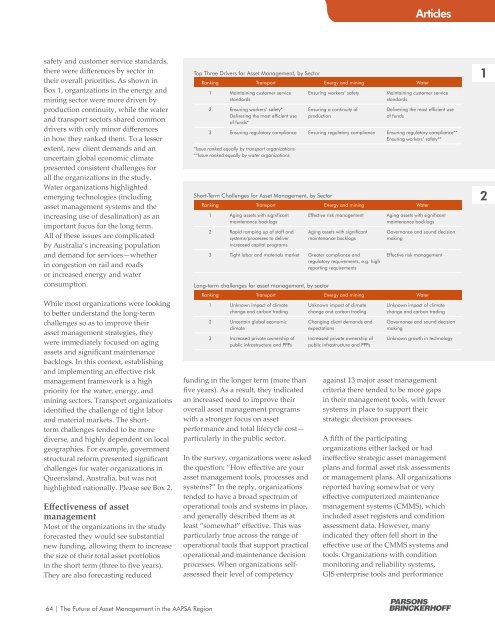June 2011 - Parsons Brinckerhoff
June 2011 - Parsons Brinckerhoff
June 2011 - Parsons Brinckerhoff
Create successful ePaper yourself
Turn your PDF publications into a flip-book with our unique Google optimized e-Paper software.
Articles<br />
safety and customer service standards,<br />
there were differences by sector in<br />
their overall priorities. As shown in<br />
Box 1, organizations in the energy and<br />
mining sector were more driven by<br />
production continuity, while the water<br />
and transport sectors shared common<br />
drivers with only minor differences<br />
in how they ranked them. To a lesser<br />
extent, new client demands and an<br />
uncertain global economic climate<br />
presented consistent challenges for<br />
all the organizations in the study.<br />
Water organizations highlighted<br />
emerging technologies (including<br />
asset management systems and the<br />
increasing use of desalination) as an<br />
important focus for the long term.<br />
All of these issues are complicated<br />
by Australia’s increasing population<br />
and demand for services—whether<br />
in congestion on rail and roads<br />
or increased energy and water<br />
consumption.<br />
While most organizations were looking<br />
to better understand the long-term<br />
challenges so as to improve their<br />
asset management strategies, they<br />
were immediately focused on aging<br />
assets and significant maintenance<br />
backlogs. In this context, establishing<br />
and implementing an effective risk<br />
management framework is a high<br />
priority for the water, energy, and<br />
mining sectors. Transport organizations<br />
identified the challenge of tight labor<br />
and material markets. The shortterm<br />
challenges tended to be more<br />
diverse, and highly dependent on local<br />
geographies. For example, government<br />
structural reform presented significant<br />
challenges for water organizations in<br />
Queensland, Australia, but was not<br />
highlighted nationally. Please see Box 2.<br />
Effectiveness of asset<br />
management<br />
Most of the organizations in the study<br />
forecasted they would see substantial<br />
new funding, allowing them to increase<br />
the size of their total asset portfolios<br />
in the short term (three to five years).<br />
They are also forecasting reduced<br />
Top Three Drivers for Asset Management, by Sector<br />
Ranking Transport Energy and mining Water<br />
1 Maintaining customer service<br />
standards<br />
2 Ensuring workers’ safety*<br />
Delivering the most efficient use<br />
of funds*<br />
funding in the longer term (more than<br />
five years). As a result, they indicated<br />
an increased need to improve their<br />
overall asset management programs<br />
with a stronger focus on asset<br />
performance and total lifecycle cost—<br />
particularly in the public sector.<br />
In the survey, organizations were asked<br />
the question: “How effective are your<br />
asset management tools, processes and<br />
systems?” In the reply, organizations<br />
tended to have a broad spectrum of<br />
operational tools and systems in place,<br />
and generally described them as at<br />
least “somewhat” effective. This was<br />
particularly true across the range of<br />
operational tools that support practical<br />
operational and maintenance decision<br />
processes. When organizations selfassessed<br />
their level of competency<br />
Ensuring workers’ safety<br />
Ensuring a continuity of<br />
production<br />
Maintaining customer service<br />
standards<br />
Delivering the most efficient use<br />
of funds<br />
3 Ensuring regulatory compliance Ensuring regulatory compliance Ensuring regulatory compliance**<br />
Ensuring workers’ safety**<br />
*Issue ranked equally by transport organizations<br />
**Issue ranked equally by water organizations<br />
Short-Term Challenges for Asset Management, by Sector<br />
Ranking Transport Energy and mining Water<br />
1 Aging assets with significant<br />
maintenance backlogs<br />
2 Rapid ramping up of staff and<br />
systems/processes to deliver<br />
increased capital programs<br />
Effective risk management<br />
Aging assets with significant<br />
maintenance backlogs<br />
3 Tight labor and materials market Greater compliance and<br />
regulatory requirements, e.g. high<br />
reporting requirements<br />
Aging assets with significant<br />
maintenance backlogs<br />
Governance and sound decision<br />
making<br />
Effective risk management<br />
Long-term challenges for asset management, by sector<br />
Ranking Transport Energy and mining Water<br />
1 Unknown impact of climate<br />
change and carbon trading<br />
2 Uncertain global economic<br />
climate<br />
3 Increased private ownership of<br />
public infrastructure and PPPs<br />
Unknown impact of climate<br />
change and carbon trading<br />
Changing client demands and<br />
expectations<br />
Increased private ownership of<br />
public infrastructure and PPPs<br />
Unknown impact of climate<br />
change and carbon trading<br />
Governance and sound decision<br />
making<br />
Unknown growth in technology<br />
against 13 major asset management<br />
criteria there tended to be more gaps<br />
in their management tools, with fewer<br />
systems in place to support their<br />
strategic decision processes.<br />
A fifth of the participating<br />
organizations either lacked or had<br />
ineffective strategic asset management<br />
plans and formal asset risk assessments<br />
or management plans. All organizations<br />
reported having somewhat or very<br />
effective computerized maintenance<br />
management systems (CMMS), which<br />
included asset registers and condition<br />
assessment data. However, many<br />
indicated they often fell short in the<br />
effective use of the CMMS systems and<br />
tools. Organizations with condition<br />
monitoring and reliability systems,<br />
GIS enterprise tools and performance<br />
1<br />
2<br />
64 | The Future of Asset Management in the AAPSA Region
















